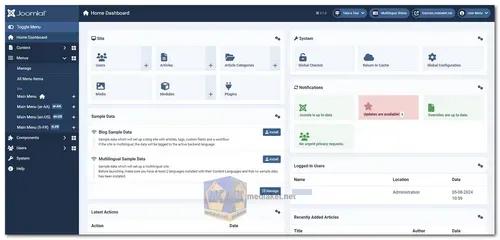Joomla is an open-source content management system (CMS) that enables users to build websites and powerful online applications. Launched in 2005, Joomla has grown into one of the most popular CMS platforms globally, powering millions of websites across various industries, including corporate portals, e-commerce sites, government applications, and community-based portals...
Here's a overview of Joomla's features:
User-Friendly Interface:
Joomla offers an intuitive and user-friendly interface, making it easy for both beginners and experienced developers to create and manage websites.
Extensibility:
With thousands of extensions available in the Joomla Extensions Directory (JED), users can extend the functionality of their websites with plugins, modules, components, and templates.
Content Management:
Joomla provides robust content management capabilities, allowing users to create, edit, publish, and manage a wide range of content types, including articles, blog posts, images, videos, and more.
Flexible Templating System:
Joomla's templating system enables users to customize the look and feel of their websites by choosing from a variety of pre-designed templates or creating their own custom templates using HTML, CSS, and PHP.
Multilingual Support:
Joomla offers built-in multilingual support, allowing users to create websites in multiple languages and easily manage content translations.
User Management:
Administrators can create multiple user groups with varying levels of access and permissions, making it easy to collaborate with team members and manage user roles effectively.
SEO-Friendly:
Joomla is designed with search engine optimization (SEO) in mind, featuring SEO-friendly URLs, metadata management, and other tools to help improve website visibility and ranking on search engine results pages (SERPs).
Security:
Joomla takes security seriously and regularly releases updates to patch vulnerabilities and protect websites from security threats. Additionally, users can enhance security with extensions like two-factor authentication and security plugins.
Scalability:
Whether you're building a small business website or a large enterprise application, Joomla offers scalability to accommodate your growing needs, with support for thousands of pages and high traffic volumes.
Community Support:
Joomla has a vibrant and active community of developers, designers, and users who contribute to its development, provide support, and share knowledge through forums, documentation, and community events.
Built-in Access Control Levels:
Joomla provides granular control over access levels, allowing administrators to define who can view, edit, publish, or manage specific content and website features.
Integration:
Joomla can be easily integrated with third-party applications and services, such as e-commerce platforms, social media networks, analytics tools, and more, through extensions and APIs.
Overall, Joomla offers a powerful and flexible platform for building and managing websites of all sizes and complexities, with a rich set of features, strong community support, and a commitment to security and extensibility. Whether you're a business owner, developer, or content creator, Joomla provides the tools and resources you need to create dynamic and engaging online experiences.
How to install and use Joomla:
Here's a step-by-step guide to using Joomla to build your website:
Preparation:
Get a domain name and web hosting: You'll need a web address (domain name) and a service to store your website's files and database (web hosting). Many web hosting providers offer one-click Joomla installation, simplifying this step.
Installing Joomla!
There are two main ways to install Joomla!: manually and using an auto-installer offered by your web hosting provider.
Manual Installation:
1. Create a MySQL database and user: You'll need a database to store your website's content. Contact your web hosting provider for instructions on creating a MySQL database and user.
2. Download the latest Joomla! version: Download the latest version compatible with your server.
3. Upload the Joomla archive and extract it: Use an FTP client to upload the downloaded Joomla! archive (usually a .zip file) to your web server. Extract the archive contents in the desired location, typically the root directory of your website (public_html).
4. Run the Joomla setup: Open your web browser and navigate to the URL where you uploaded the Joomla! files. This could be `http://www.yourdomain.com` or `http://localhost/your-website-folder` depending on your setup. You'll see the Joomla! installation wizard.
5. Follow the on-screen instructions: The wizard will guide you through setting up your Joomla! website, including configuration details like site name, database information, administrator username and password, and email address.
Using an Auto-Installer:
Many web hosting providers offer auto-installers for popular applications like Joomla!. Check your web hosting control panel for an auto-installer option. The specific steps will vary depending on your provider, but generally involve selecting Joomla! from the list of applications, providing basic configuration details, and clicking install.
Using Joomla!
Once Joomla! is installed, you can access the administrator panel (backend) by appending `/administrator` to your website URL (e.g., `http://www.yourdomain.com/administrator`). Here, you can manage your website content, create pages and menus, install extensions for additional features, and configure various settings.
For detailed instructions with screenshots, refer to the official Joomla! documentation.
Download Joomla:
Size: 28.95 MB

